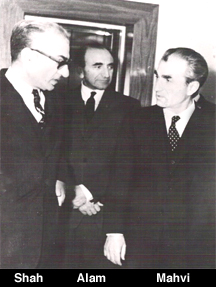
The Iranian nuclear enrichment program and its potential to create weapon- grade uranium that could be used for making bombs is the hottest topic of discussion among the western powers and international community. In order to better understand Iran’s intention, one must look back to its origin and study the history behind its current activities. Iran’s ambitious plan to acquire nuclear power is nothing new and dates back to the late Shah of Iran. Henceforth, I will refer to him as the “Shah” [1]. It was his government’s desire to acquire the nuclear technology.
During the past several years, a number of misguided attempts have been made to uncover the truth behind Iran’s nuclear activities.
Unfortunately, a number of interviews given by the former head of the Iranian Nuclear Energy Organization, Dr. Akbar Etemad [2], to various news outlets including the British Broadcasting Corporation, Radio Farda [3] and Le Monde [4] Newspaper have caused greater confusion and misunderstanding. In addition, a documentary published by historian, Mr. Gholam Reza Afkhami [5] “.
FLOTNOTES
[1] Shah –An Iranian term for a monarch (leader). Mohammad Rezā Shāh Pahlavi, Shah of Iran, (October 26, 1919, Tehran – July 27, 1980, Cairo), styled His Imperial Majesty, and holding the imperial titles of Shahanshah (King of Kings), and Aryamehr (sun of the Aryans), was the monarch of Iran from September 16, 1941, until the Iranian Revolution on February 11, 1979. He was the second monarch of the Pahlavi House and the last Shah of the Iranian monarchy
[2] Dr. Akbar Etemad – Director of the Atomic Energy Organization of Iran (AEOI) 1974 – 1978.
[3] Radio Farda – Radio Farda and RadioFarda.com is a joint project of Radio Free Europe/Radio Liberty (RFE/RL) and Voice of America (VOA).
[4] Le Monde – French newspaper
[5] Gholam Rez Afkhami – Barnameh-ye enerji-ye atomi-ye iran, talash-ha va tanesh-haa, a history of Iran’s Atomic Energy Program as told by Akbar Etemad,. The book, published in 1997 by the Foundation for Iranian Studies in Bethesda, Maryland, USA
[6] Siemens/KWU – In the 1960s, AEG and Siemens merged their activities in the sector of conventional and nuclear power plants, Kraftwerk Union AG
[7] Baha-Edin-Mirza Dadston –Abolfath Mahvi father’s uncle son (cousin) who married the Shah full aunt
[8] Major General (Sar Lash Kar) Farhad Dadseton – Tehran Military Governor
[9] Lieutenant General (Sepah Bod) Iraj Mahvi – Commander of Imperial Guard
[10] Amir Assdollah Alam – The longest serving minister of the Pahlavi’s Royal Court 1919 -1978
[11] John F. Kennedy – John Fitzgerald “Jack” Kennedy (May 29, 1917–November 22, 1963), often referred to by his initials JFK, was the thirty-fifth President of the United States
[12] Lyndon Johnson – (1908 – 1973), often referred to as LBJ, was the thirty-sixth President of the United States, serving from 1963-1969
[13] PanAm Oil – Pan American Petroleum & Transport Company, Standard (Indiana) Oil or Amoco
[14] Reza Fallah – Deputy chairman of the Iran’s National Oil Company from 1974 to 1979
[15] Moharram – The Islamic year begins on the first day of Muharram, and is counted from the year of the Hegira (anno Hegirae)—the year in which Muhammad emigrated from Mecca to Medina (A.D. 622)
[16] Malekeh Madar –
[17] Dr. Hassan Imami – The shah own cleric-incourt, Sayyid Hassan Imami, the Imam Jum’ ah of Tehran
[18] Amir Abbas Hoveyda – Prime Minister of Iran (1965-1979).
[19] Abolfath Atabay – Royal Court Deputy
[20] Mohammad Ali Mahdavi – Owner of Shiravon Sugar Factory
[21] Amir Hoshang Davanloo – Head of Royal Festivity and Events
[22] General Hassan Tofunnian – Vice Minster of War
[23] Mohammad Sadegh Saeedi – Former Managing Director of IBM in Iran and president of INECO.
[24] Bechtel – Nearly two-thirds of the U.S. nuclear power plants rely on Bechtel for operating serves. Since 1957, Bechtel had prime responsibility for more commercial generating plants than any other firm, accounting for more than 1200 reactor years of operation.
[25] Reza Fallah – Deputy chairman of the Iran’s National Oil Company from 1974 to 1979
[26] Mesbah Jollynous – Former Managing Director of Tavanir
[27] KWU – Siemens/KWU – In the 1960s, AEG and Siemens merged their activities in the sector of conventional and nuclear power plants, Kraftwerk Union AG
[28] Asfiyar – Former head of the Planning Organization
[29] Reza Ghotbi – Head of the National Iranian Radio and Television 1967-1979, Son of Mohammad Ali Ghotbi, cousin of Farah Pahlavi (Diba), Empress of Iran, a widow and wife of Mohammad Reza Pahlavi, the late Shah of Iran.
[30] Dr. Manouchehr Eghbal, Chairman of National Iranian Oil Company
[31] Princes Ashraf Pahlavi – The twin sister of Mohammad Reza Pahlavi, the last Shah of Iran and the Pahlavi Dynasty
[32] Reza Pahlavi – The Crown Prince – He succeeded his father as Head of the House of the Pahlavi dynasty living in exile
[33] Majlis – The National Consultative Assembly, Majlis was also the name of the lower house of the Iranian Legislative body from 1906 to 1979, the upper house being the Senate – also the Iranian Parliament
[34] Mohammad Sadegh Saeedi- Managing Director or INECO and former President of IBM in Iran.
[35] Ahmad Sotoodehnia – Dr. Etemad ‘s Vice President at AEOI who replaced Etemad in 1978
[36] Hans George Wiek – German Ambassador to Tehran/Iran 1974-1977
[37] Framatome SA – Called Franco-Américaine de Constructions Atomiques (Framatome), the original company consisted of four engineers, one each from each of the parent companies. The original mission of the company was to act as a nuclear engineering firm and to develop a nuclear power plant that was to be identical to Westinghouse’s existing product specifications – It is a diversified, international manufacturing company and also the world leader in nuclear power generation.
[38] Abdol Aziz Farmonfarmayan was of the most famous Iranian Architect and the owner of Farmanfarmayan Company. He built Niavaran Palace in Northern Tehran
[39] Abdol Reza Ansari – Governor of Khuzestan, Deputy Finance Minister, Treasurer, Minister of Labour
[40] Majles-e Shura-ye Melle – The National Consultative Assembly, Majlis was also the name of the lower house of the Iranian Legislative body from 1906 to 1979, the upper house being the Senate – also the Iranian Parliament
[41] Amir Abbas Hoveyda – He served as Prime Minister of Iran from January 27, 1965 to August 7, 1977.
[42] Dr. Jamshid Amuzegar – (also Amouzegar) (1923 – ) is a former Prime Minister of Iran
[43] Hushang Ansary – Minister of Finance and Economic Affairs under Prime Minister Amir Abbas Hoveyda of Iran. He also served as the last President of National Iranian Oil Company
[44] Henry Kissinger – Secretary of State in the Richard Nixon administration (1973 – 1977)
[45] Giscard d’Estaing was President of the French Republic from 1974 until 1981
[46] Reza Ghotbi – Head of the National Iranian Radio and Television 1967-1979, Son of Mohammad Ali Ghotbi, cousin of Farah Pahlavi (Diba), Empress of Iran, a widow and wife of Mohammad Reza Pahlavi, the late Shah of Iran.
[47] Kayhan Newspaper was originally established during the Pahlavi era, it became the most famous and respected newspaper of its time. When the Shah of Iran was overthrown in 1979, all of its assets were seized, including the publishing plant which was the main headquarters of Kayhan Newspaper. The London offices of Kayhan continued but it currently has a small circulation in comparison to what it once had pre-revolution times.
[48] Princes Ashraf Pahlavi – Princess (Shahdokht) Ashraf ul-Mulk (born October 26, 1919), is the twin sister of Mohammad Reza Pahlavi, the last Shah of Iran and the Pahlavi Dynasty.






